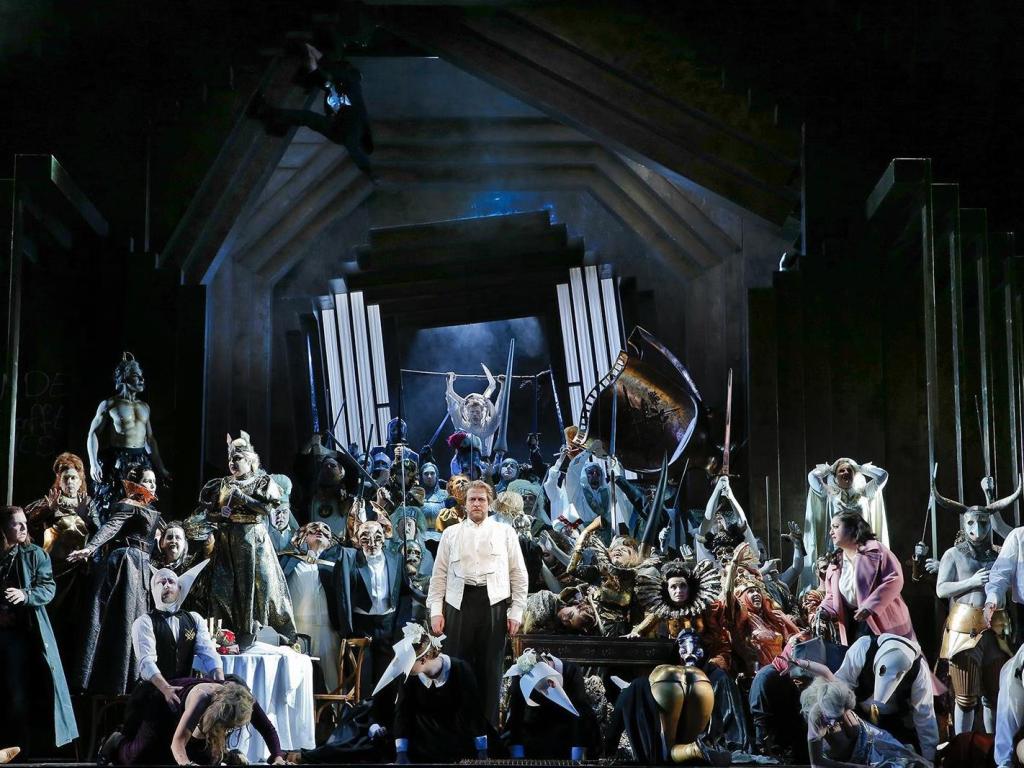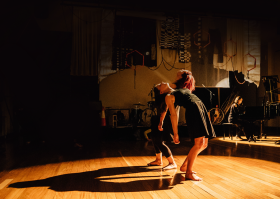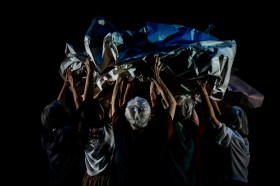The cast of Opera Australia’s 2018 production of Die Meistersinger von Nürnberg at the Arts Centre Melbourne. Photo credit: Jeff Busby.
In this production of Wagner’s opera about the tension between creative innovation and tradition, the story’s rebel scrawls on the wall: ‘Kinder schafft NEUES!’, or ‘children, make something new’, as the composer himself once exhorted. Director Kasper Holten takes this to heart with a contemporary setting that ranges from incongruous to spectacular, and a twist at the end that Wagner would surely have found far too new.
Indeed when this co-production made its debut at the Royal Opera House, Covent Garden, last year, reception was decidedly mixed, some considering it a wonderfully refreshing take, while one critic went so far as to describe it as ‘idiocy.’ Whatever one’s view of it as theatre, however, opening night of Opera’s Australia’s Die Meistersinger von Nürnberg was musically magnificent thanks to a talented local cast bolstered by two splendid German imports and Orchestra Victoria, filling the State Theatre pit’s expanded Wagnerian configuration.
First performed in Munich in 1868, this opera is inspired by the singing guilds that thrived in Germany from the 14th to 16th centuries. Their male, middle-class, rule-obsessed members were known as meistersingers (master singers). Wagner’s are drawn from history, most notably Hans Sachs, a renowned Nuremberg cobbler-poet. In Die Meistersinger von Nürnberg, Sachs befriends newcomer Walther von Stolzing, a rebellious knight ignorant of the guild’s rules but blessed with a talent for creating and singing songs.
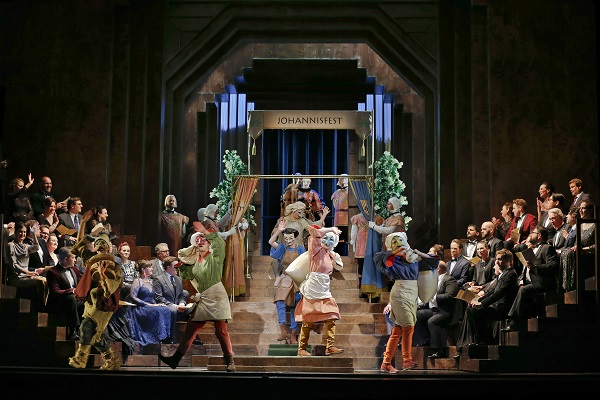
The Opera Australia ensemble in Opera Australia’s 2018 production of Die Meistersinger von Nürnberg at the Arts Centre Melbourne. Photo credit: Jeff Busby.
Love has blossomed between Walther and Eva, the daughter of another meistersinger, Pogner, who offers her as the prize for a song contest. Fellow meistersinger Beckmesser also loves her, so takes relish in rejecting Walther’s innovative audition. Though an admirer of Eva too, Sachs helps Walther triumph in the end, partly by making the pedantic Beckmesser look ridiculous.
Holten’s setting is loosely contemporary, but there’s loads of 20th century design that highlights the guild’s old-fashioned outlook – most notably their clubroom, a grand set of Art Deco wood panelling. Mia Stensgaard’s tiered design works brilliantly as a stage for the vast cast for much of the four-plus hour run time (excluding intervals – audience stamina is essential!), including for the lavish bacchanal at Act II’s conclusion. In fact the set is stunning at this point, as sections revolve with aerialists clinging on, like a German Expressionist nightmare.
At other times it’s utterly incongruous, as the clubroom doubles as Sachs’ shoemaking workshop and the street where Beckmesser goes serenading, while Act III’s revelation that it’s all just a set, as the backstage structure is revealed, suggests a poorly formed idea about theatre versus reality.
Anja Vang Kragh’s costumes mix glamorous modern evening wear with past looks, most notably in the grand finale’s pageant and the meistersingers’ regalia, which draws on their centuries-old traditions with heavy livery collars, embroidered Masonic-style aprons and ostentatious Renaissancesque drapery and hats.
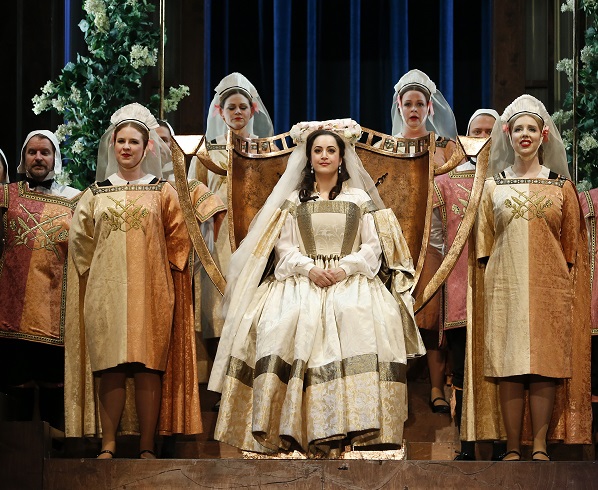
Natalie Aroyan as Eva and the Opera Australia ensemble in Opera Australia’s 2018 production of Die Meistersinger von Nürnberg at the Arts Centre Melbourne. Photo credit: Jeff Busby.
Vang Kragh throws everything at the eye-popping bacchanal crowd, from Medieval masks to the cloven hooves of a watchmen-turned-satyr (bravo Adrian Tamburini for negotiating this towering footwear, bare-chested, singing all the while). Walther’s costume is an ugly puzzle, however, as his long hair, jeans and retro floral shirt with coattails makes him look like a bumpkin rather than an important if nonconformist nobleman.
Despite this unflattering get-up, Stefan Vinke was assured as Walther. He conveyed the shades of this young hero’s passion, and sang with the extraordinary stamina and control that Melbourne audiences will remember from his standout Siegfried in Opera Australia’s 2013 and 2016 Ring Cycles. The German tenor’s golden tone was particularly delightful during Act I’s Trial Song, though tiny flashes of strain were evident hours later in his Prize Song.
Fellow German Michael Kupfer-Radecky seemed effortless as Sachs, which is particularly remarkable given he was only announced as a late replacement a week before opening night. Though not new to the role, he is very new to this production, yet his Sachs was the dignified, emotionally nuanced centrepiece of it all and his baritone rich and measured.
Locals also shone brightly, particularly Natalie Aroyan, who interpreted Eva with a bright, powerful soprano and determined streak, and Warwick Fyfe, a comic veteran whose burnished baritone perhaps never sounded better even while he oozed Beckmesser’s slimy pompousness.
With his pure, sweet voice and lively acting, young tenor Nicholas Jones was excellent as the apprentice David, and shared a nice rapport with Dominica Matthews, playing his girlfriend and Eva’s nurse (more like PA in this production), Magdalene. Daniel Sumegi brought his usual authority in voice and deed to Pogner, and was joined by an embarrassment of talented meistersingers including Luke Gabbedy, Kanen Breen and John Longmuir.
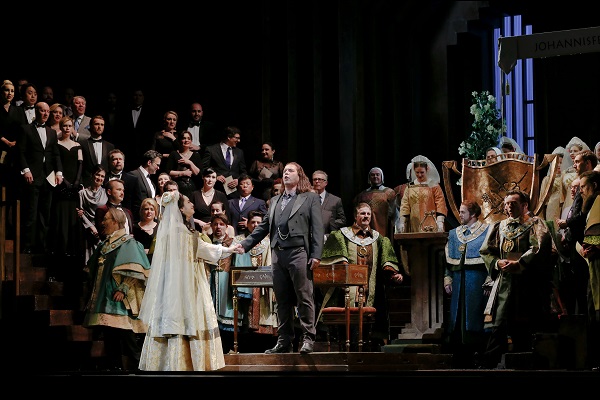
Natalie Aroyan as Eva, Stefan Vinke as Walther Von Stolzing and the Opera Australia ensemble in Opera Australia’s 2018 production of Die Meistersinger von Nürnberg at the Arts Centre Melbourne. Photo credit: Jeff Busby.
The Opera Australia Chorus, under the direction of Anthony Hunt, sounded glorious en masse and also expertly executed the demanding stage business and choreography. Pietari Inkinen marshalled the super-sized Orchestra Victoria as he did for Melbourne’s recent Ring Cycles: the band’s lush strings and evocative horns were full of drama but never overwhelmed the singers.
Eva’s silent horror when her beloved ultimately joins the guild is Holten’s radical final evocation of ‘Kinder schafft NEUES!’ Is it a contemporary smackdown of the opera’s conservatism, as Walther’s innovation and naturalism is subsumed into the guild’s rules and old-fashioned values? Instead of the usual boy-gets-girl, is it feminist outrage by this woman who has been reduced to a prize? Is she expressing modern audience’s discomfort with the opera’s concluding praise of German culture and purity, which made Die Meistersinger von Nürnberg a Nazi favourite? Perhaps like some other aspects of this production, her horror is simply too incongruous to work, but it’s certainly new.
4 stars ★★★★
Opera Australia
Director: Kasper Holten
Revival director: Dan Dooner
Conductor: Pietari Inkinen
Set designer: Mia Stensgaard
Costume designer: Anja Vang Kragh
Hans Sachs: Michael Kupfer-Radecky
Walther von Stolzing: Stefan Vinke
Eva: Natalie Aroyan
Sixtus Beckmesser: Warwick Fyfe
David: Nicholas Jones
Magdelene: Dominica Matthews
Veit Pogner: Daniel Sumegi
13-22 November 2018
Arts Centre, State Theatre, Melbourne
